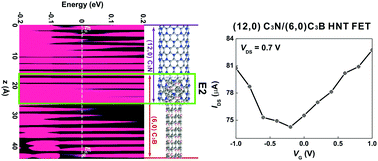Ballistic transport simulation of acceptor–donor C3N/C3B double-wall hetero-nanotube field effect transistors†
Abstract
The one-dimensional (1D) acceptor–donor (A–D) hetero-nanotube (HNT) has attracted much attention as a potential candidate for a channel structure of next-generation field effect transistors (FETs). Herein, we designed A–D C3N/C3B double-wall (dw) HNTs by coaxially wrapping C3N and C3B nanotubes together. By using density functional theory (DFT) combined with the nonequilibrium Green's function (NEGF) formalism, we studied the electronic properties and ballistic transport behavior of C3N/C3B dwHNTs in comparison with the ones in vertical stacking contact. The remarkable charge transfer between C3N and C3B nanotubes and band hybridization in C3N/C3B dwHNTs originate from the strong intertubular π–π stacking interaction. In the simulated all-around-gated FET devices, (12,0) C3N/(6,0) C3B dwHNT with 2 repeated wrapping units possesses the optimal performance, including rectifying ratio and subthreshold swing (SS), by enhancing the A–D asymmetry. Our work suggests that coaxial wrapping is a method superior to vertical stacking in constructing A–D HNTs for high-performance electronic and optoelectronic devices based on 1D materials.



 Please wait while we load your content...
Please wait while we load your content...